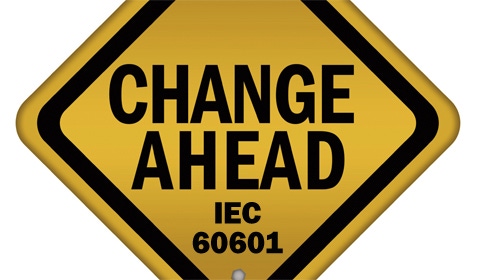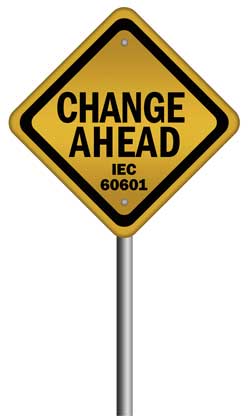Is the Third Edition of 60601 the End of Objective Evidence?
Although the transition period for the third edition of the medical electrical equipment standard (IEC 60601-1:2005) doesn’t end until 2012, there are many changes and firsts that design engineers must become familiar with now. Concepts such as essential performance, reducing risk, and protecting patients are unique to this new version of the standard.
April 27, 2011

Although the transition period for the third edition of the medical electrical equipment standard (IEC 60601-1:2005) doesn’t end until 2012, there are many changes and firsts that design engineers must become familiar with now. Doing so ensures that they design electronic products and components that will come up to scratch and can be sold on the global market. The EU will be the first body to fully adopt the third edition, and will therefore be the primary focus of this discussion.
 For many, the third edition represents a much-needed update because the use of medical equipment in clinics and in homes has changed significantly. Electronic medical equipment is omnipresent in people’s lives and the updated standard aims to reflect those changes (see the sidebar on collateral standards).
For many, the third edition represents a much-needed update because the use of medical equipment in clinics and in homes has changed significantly. Electronic medical equipment is omnipresent in people’s lives and the updated standard aims to reflect those changes (see the sidebar on collateral standards).
The end of the transition period is still two years away, but it makes commercial sense to start using this new, more complex, and greatly expanded standard now. Incorporating it into the design process now will help to avoid costly redesigns and potential delays in time to market for products further down the line.
Falling Foul of the Law
Previous versions of IEC 60601-1 only covered products intended for use ”under medical supervision.” However, consumers have never been more aware of the state of their health, and consequently there has been a boom in the home health and self-test electronic products industry. The use and location of medical equipment has changed and it has become necessary to increase the scope of the standard. As a result, a good number of health-related electronic devices that were not covered by previous standards, will be addressed by the requirements defined in the third edition. Manufacturers of active devices, such as seasonal affective disorder lamps, fitness machines, and depilation equipment, must now be careful of the claims they make, because careless marketing language could get a product classified as a medical device. Then it will have to meet the complex requirements of IEC 60601-1 as well as the Medical Devices Directive 93/42/EEC as amended by directive 2007/47/EC. Such categorization could cost extra money and delay in getting the product to market with further external regulatory scrutiny by way of a Notified Body.
Because manufacturers that sell health-related products will be at an increased risk of inadvertently falling foul of the law, it is essential that companies consider early in the design phase how a product will be used and who it will be marketed to. Such consideration ensures that products meet the robust standard as necessary and can be legally sold after the 2012 implementation date.
Reducing Risk
As a harmonized standard (under the Medical Devices Directives 93/42/EEC as amended by directive 2007/47/EC), one of the many new requirements is the incorporation of the concept of risk management. It includes an obligation to keep a detailed risk management file (RMF). Many of the tests that are required to demonstrate compliance with the standard make reference to the RMF.
An increased level of flexibility must be introduced, because it enables the testing process, which is required to ensure compliance with the standard, to be modified depending on how the device complies with some aspects of the standard. For example, some medical equipment may need to be robust enough to withstand battlefield or other extreme conditions.
The testing house selected can therefore toughen the use standards and associated risk (e.g., increase requirements for shock or heat resistance). However, the new element of risk management in the third edition of the standard has raised some concerns. Critics say that the risk management rules are open to interpretation and could introduce a degree of subjectivity, thereby moving away from objective pass-fail criteria. One testing house could determine a pass and another could use the same data to determine a failure.
The third edition introduces the concept of essential performance, which may be a surprise to those purchasing equipment. Essential performance expands the scope of the standard beyond basic safety requirements to ensure that the product does the job from the end-user’s perspective.
Another new requirement is causing some ripples in the medical device world. The lifetime of the equipment must be planned for and documented. A manufacturer must estimate the product lifetime and, by implication, the mean time between failures, the availability of spare parts, and how long the manufacturer will support that equipment. Although this is reassuring for purchasers making a significant investment in expensive medical equipment, it translates to significant challenges from a marketing and sales perspective.
The new requirements help users get a better idea of their return on investment when comparing equipment from different manufacturers. The standard provides the purchaser with knowledge of how long a particular product is predicted to last and for how long they will be able to repair it. Purchasers can therefore assess a product’s long-term potential and cost effectiveness compared with competitive products.
There is a also record-keeping implication as Directive 93/42/EEC requires manufacturers to keep records for the lifetime of nonimplantable products, and for an additional five years after the product has been retired. Records must be kept of implantable products 15 years after production has stopped.
Increased Patient Protection
The standard includes new concepts for means of patient and operator protection. Previous versions of the standard have allowed a current was allowed to appear on the conductive enclosure of the medical equipment in question, exposing the user or patient to a small level of current. Although there are greatly increased figures for earth leakage current in the new standard, the additional current is now confined to the earth continuity conductor of the product. These changes significantly influence the design of many medical devices that have been used for several years—manufacturers that want to continue selling products may need to invest in a redesign. On the positive side, this increased earth leakage current allowance enables the use of more-substantial mains interference filters.
Mechanical hazard protection has also been expanded significantly. The standard now covers trapping points, which had not been taken into consideration before. The addition makes perfect sense when you consider that equipment is used to manage patients, rather than directly treat them. Equipment that is not thoroughly tested for hazards beyond electric shock could cause harm to the patient. When designing equipment such as dentist chairs and patient hoists, more detailed mechanical safety checks must now be conducted.
The standard now also covers batteries and battery charging circuits. The best advice would be to use a power source within the product that already carries a certificate proving compliance with the third edition of 60601. If such battery components are not used then they will require additional testing under the new standard. Such testing can be a lengthy and expensive process because the batteries must be proven safe under all possible environmental conditions in which the device may be used across its expected working life. Such tests must also cover the full range of safety tests such as misuse, temperature, orientation, and ingress of fluids.
A RMF should accommodate designs for which batteries might be left idle for long periods of time. One example of such a condition is automated external defibrillators units that are stored in public places (e.g., shopping centers, offices, etc.). Users require assurance that the device will work on the rare occasion it is needed. The same requirement might apply to a battery-operated relief kit for asthmatics.
Modernizing the Approach
Although the third edition of IEC 60601 may be viewed by designers of medical equipment as yet another hoop to jump through, it is intended to help them keep pace with a rapidly changing technological world. Applying standards created more than 30 years ago would be pointless and would not adequately protect manufacturers, end-users, or patients.
The good news for device makers is that the third edition includes extremely extensive explanatory material. It aims to give designers and testers an increased insight into the rationale behind clauses, and therefore a more comprehensive understanding of the requirements.
Getting to grips with these significant changes when designing active medical devices may take some effort now, but it should prove to be a good return on investment. Those who wait until 2012 to have their products tested against the new standard will find that testing houses are booked solid as the deadline approaches. If a product isn’t approved in time it will have to be withdrawn from the market until tests are completed. Invest in appropriate redesigns now and have them tested against the new standard to reap rewards further down the line.
Jean-Louis Evans is managing director at TÜV SÜD Product Service.
About the Author(s)
You May Also Like


